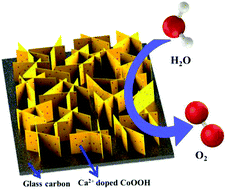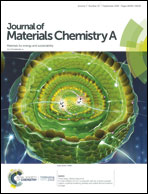Ca2+-doped ultrathin cobalt hydroxyl oxides derived from coordination polymers as efficient electrocatalysts for the oxidation of water†
Abstract
The development of highly efficient oxygen evolution reaction (OER) electrocatalysts is critical because the sluggish reaction kinetics of this reaction usually hinders the efficiency of water electrolysis for the generation of H2. Herein, we report that ultrathin cobalt-based coordination polymers (Co-CPs) plates are exceptional electrocatalysts for the OER as they show one of the most lowest Tafel slopes among the cobalt-based OER catalysts reported to date. It has been found that the Co-CPs can be transformed into Co(OH)2 hexagonal nanoplates and then further oxidized into CoOOH, which acts as a catalytic active site for the oxidation of water. Interestingly, when Ca2+, an inactive ion, was introduced into the precursors, thinner CoOOH nanosheets with more exposed active sites were formed, which displayed significantly higher OER activity than the Co-CPs. Furthermore, the content of Ca2+ in the Co-based coordination polymers (CoxCay-CPs) and the corresponding OER activity of these CPs were systematically investigated, and Co0.89Ca0.11-CPs exhibited highest OER activity. This study provides a fundamental understanding of the catalytic mechanism of cobalt-based coordination polymer electrocatalysts and the effect of inactive species, such as Ca2+, on the OER in an alkaline electrolyte, which may promote the design of highly active electrocatalysts.



 Please wait while we load your content...
Please wait while we load your content...